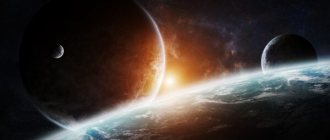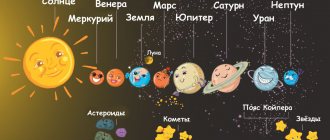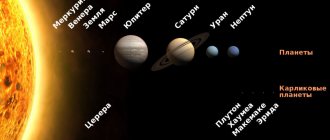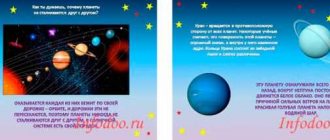When we raise our eyes to the sky, we see a lot of interesting things: during the day - the bright sun, airy clouds, a rainbow after rain or thunderclouds, and at night we watch the moon and admire the twinkling of many stars. The huge world above our heads is called the Universe or space. Space is so big that scientists still don't know much about it. For many years, people have been exploring outer space with the help of telescopes and spacecraft that explore the far corners of the Universe. Thanks to these inventions, we learned a lot of interesting things: what is the size of the sun, is it possible to live in space, and how long does it take to fly to other stars. However, the Universe is so huge and diverse that there are still many amazing discoveries ahead.
Development and education of children from 2 to 11 years old in a playful way
Start practicing right now
Start practicing
What is the Sun?
The sun that we see every day is a large and bright star. And what is it? A star is a huge hot ball of gas. There are a lot of different stars in space, but they are so far from us that they seem to us like small luminous points. The Sun is the closest star to us, so we see it very well. The bright and hot Sun gives light and warmth to all living things - from trees and flowers to animals and people.
Our home is planet Earth
If the Sun is a ball of gas, then maybe we also live on a star? Of course not. Under our feet there is a hard surface on which we can walk, run, rollerblade and ride a car. This cannot be done on the Sun, because it consists of gas. What then should we call the place where we live? Welcome to planet Earth! A planet is a space object that looks like a huge ball. There are several other planets near the Earth, and they are all very different: large and small, cold and hot, fast and slow. Let's get to know them!
Sun
The Sun is the star around which all the planets and satellites in the solar system revolve. It consists of hydrogen and helium. The age of the Sun is 4.5 billion years, it is only in the middle of its life cycle, gradually increasing in size. Now the diameter of the Sun is 1,391,400 km. In just the same number of years, this star will expand and reach the orbit of the Earth.
The sun is the source of heat and light for our planet. Its activity increases or becomes weaker every 11 years.
Due to the extremely high temperatures on its surface, a detailed study of the Sun is extremely difficult, but attempts to launch a special device as close to the star as possible continue.
Planets of the Solar System
In addition to the Earth, there are many other planets in space, but there are very few of them near us - only eight. These planets, together with the Earth, revolve around the star closest to us - the Sun. It attracts planets to itself as if they were its relatives. Scientists called such a cosmic family the Solar System. There are eight planets in the solar system. If you arrange them from closest to the Sun to the farthest, then the first will be Mercury, the second will be Venus, the third will be Earth, the fourth will be Mars, the fifth will be Jupiter, the sixth will be Saturn, the seventh will be Uranus, and the eighth planet will be Neptune. Planets are not just are close to the Sun, and all the time they revolve around it along their path, as if they were dancing in a circle. This path is called an orbit. Each planet has its own orbit, for example, the Earth makes a full revolution around the Sun in 365 days or, in another way, in one year. Did you know that each planet not only revolves around the Sun, but also rotates around its axis like a top? We call one revolution around its axis a day. On Earth, a day lasts 24 hours, but on other planets, a day passes either faster or much longer.
Terrestrial group of planets
Mercury
This planet is one of the smallest in the solar system, its diameter is 4,879 km. In addition, it is closest to the Sun. This proximity predetermined a significant temperature difference. The average temperature on Mercury during the day is +350 degrees Celsius, and at night - -170 degrees.
If we take the Earth year as a guide, Mercury makes a full revolution around the Sun in 88 days, and one day there lasts 59 Earth days. It was noticed that this planet can periodically change the speed of its rotation around the Sun, its distance from it and its position.
There is no atmosphere on Mercury; therefore, it is often attacked by asteroids and leaves behind a lot of craters on its surface. Sodium, helium, argon, hydrogen, and oxygen were discovered on this planet.
A detailed study of Mercury is very difficult due to its close proximity to the Sun. Sometimes Mercury can be seen from Earth with the naked eye.
According to one theory, it is believed that Mercury was previously a satellite of Venus, however, this assumption has not yet been proven. Mercury does not have its own satellite.
Venus
This planet is the second from the Sun. In size it is close to the diameter of the Earth, the diameter is 12,104 km. In all other respects, Venus differs significantly from our planet. A day here lasts 243 Earth days, and a year lasts 255 days. The atmosphere of Venus is 95% carbon dioxide, which creates a greenhouse effect on its surface. This results in an average temperature on the planet of 475 degrees Celsius. The atmosphere also contains 5% nitrogen and 0.1% oxygen.
Unlike the Earth, most of whose surface is covered with water, there is no liquid on Venus, and almost the entire surface is occupied by solidified basaltic lava. According to one theory, there used to be oceans on this planet, however, as a result of internal heating, they evaporated, and the vapors were carried away by the solar wind into outer space. Near the surface of Venus, weak winds blow, however, at an altitude of 50 km their speed increases significantly and amounts to 300 meters per second.
Venus has many craters and hills that resemble the earth's continents. The formation of craters is associated with the fact that the planet previously had a less dense atmosphere.
A distinctive feature of Venus is that, unlike other planets, its movement occurs not from west to east, but from east to west. It can be seen from Earth even without the help of a telescope after sunset or before sunrise. This is due to the ability of its atmosphere to reflect light well.
Venus has no satellite.
Earth
Our planet is located at a distance of 150 million km from the Sun, and this allows us to create on its surface a temperature suitable for the existence of liquid water, and, therefore, for the emergence of life.
Its surface is 70% covered with water, and it is the only planet to contain such an amount of liquid. It is believed that many thousands of years ago, steam contained in the atmosphere created the temperature on the Earth's surface necessary for the formation of water in liquid form, and solar radiation contributed to photosynthesis and the birth of life on the planet.
The peculiarity of our planet is that under the earth’s crust there are huge tectonic plates, which, moving, collide with each other and lead to changes in the landscape.
The diameter of the Earth is 12,742 km. An earthly day lasts 23 hours 56 minutes 4 seconds, and a year lasts 365 days 6 hours 9 minutes 10 seconds. Its atmosphere is 77% nitrogen, 21% oxygen and a small percentage of other gases. None of the atmospheres of other planets in the solar system has such an amount of oxygen.
According to scientists, the age of the Earth is 4.5 billion years, approximately the same age that its only satellite, the Moon, has existed. It is always turned to our planet with only one side. There are many craters, mountains and plains on the surface of the Moon. It reflects sunlight very weakly, so it is visible from Earth in the pale moonlight.
Mars
This planet is the fourth from the Sun and is 1.5 times more distant from it than the Earth. The diameter of Mars is smaller than Earth's and is 6,779 km. The average air temperature on the planet ranges from -155 degrees to +20 degrees at the equator. The magnetic field on Mars is much weaker than that of Earth, and the atmosphere is quite thin, which allows solar radiation to unimpededly affect the surface. In this regard, if there is life on Mars, it is not on the surface.
When surveyed with the help of Mars rovers, it was found that there are many mountains on Mars, as well as dried up river beds and glaciers. The surface of the planet is covered with red sand. It is iron oxide that gives Mars its color.
One of the most frequent events on the planet are dust storms, which are voluminous and destructive. It was not possible to detect geological activity on Mars, however, it is reliably known that significant geological events previously occurred on the planet.
The atmosphere of Mars consists of 96% carbon dioxide, 2.7% nitrogen and 1.6% argon. Oxygen and water vapor are present in minimal quantities.
A day on Mars is similar in length to those on Earth and is 24 hours 37 minutes 23 seconds. A year on the planet lasts twice as long as on Earth - 687 days.
The planet has two satellites Phobos and Deimos. They are small in size and uneven in shape, reminiscent of asteroids.
Sometimes Mars is also visible from Earth with the naked eye.
Nimble Mercury
Mercury is closest to the Sun - it is the smallest planet in the solar system. Mercury orbits the Sun the fastest, but it moves much slower on its axis. Because of this, it is always hot on one side, because the Sun is very hot. On the other side, on the contrary, it is very cold, because the sun's rays almost do not reach there. That's how amazing small and nimble Mercury is.
Dangerous Venus
In second place from the Sun is the planet Venus. It is very similar in size to our Earth, but people will not be able to live there. The air of Venus contains many poisonous gases that are impossible to breathe. And the surface of the planet gets very hot, so there is always intense heat there. Astronauts cannot go to explore Venus because the heat would immediately melt the rocket. This is the hottest planet in the solar system!
Welcome to Earth!
We have already flown past Mercury and Venus, which means we will see Earth very soon. Our planet will be the third from the Sun. In size, the Earth is not the largest and not the smallest, but it is very different from others. With what? Our planet is the only place in the solar system where life exists. Thanks to its location from the Sun, water and clean air, living organisms began to appear on Earth many thousands of years ago. Only here you can see plants and animals, hear birds singing and visit many cities and countries where people live.
There is an interesting “neighbor” near our planet - the Moon. This is what we see in the sky every night. The Moon is a satellite of the Earth, which means that it revolves around our planet. The moon is so close to us that astronauts have even been there. Perhaps very soon scientists will begin to build special bases on the Moon where people can live.
Ninth, tenth and wandering planets
Until 2006, astronomers officially believed that there was a 9th planet called Pluto, but due to recent research it has been classified as a dwarf planet. However, not all astronomers agree with this opinion. The surface of this celestial theme is considered the coldest in the solar system.
It is located very far from Earth, which means there is a lack of information about its exact dimensions and main chemical elements. In 2015, the New Horizons spacecraft was able to transmit some information. So it was determined that its diameter is more than 2300 km.
At the very edge of the solar system, not far from the Kuiper Belt, scientists have discovered a region of space where thousands of icy celestial bodies, small in size, are located. The main scientific theory, not officially accepted, suggests that this is where the 9th planet is located.
Researchers Brown and Batygin put forward a concept according to which it appeared within the Solar System, and then it was thrown virtually beyond its boundaries by the gravitational forces of the gas giants, Jupiter or Saturn, or both.
Astronomers concluded the existence of such a planet by analyzing the orbital deviations of 600 Kuiper Belt bodies. They suggested that they are influenced by the gravitational field of a large unknown celestial body the size of Mars, which has not yet been noticed by astronomers. This theory has not been proven.
In the 20th century, a theory appeared about a planet that could be located between Mars and Jupiter. At the moment, this concept is closer to the legend, which was first voiced by the American Immanuel Velikovsky.
He believed that the planet Tiamat, or Phaethon, was destroyed due to the passage of a large celestial body through the solar system. As a result, an asteroid belt appeared behind Mars. The American Zecharia Sitchin, studying Sumerian clay tablets, concluded that there may be a “wandering planet”, which they called Nibiru.
Iron Mars
The fourth planet from the Sun is called Mars. It is unusual in that its entire surface is covered with iron. Because of this, the planet has a reddish-orange hue. Although Mars is smaller than Earth, a day on it lasts almost like ours - 24 hours 37 minutes. But the Martian year is much longer than the Earth's. In search of an answer to the question “Is there life on Mars?”, scientists have created special vehicles - rovers that walk on the surface of Mars and study the red planet. However, so far they have not been able to find signs of life on Mars.
Interesting Facts
- Venus is also called the Morning and Evening Star. This is due to the fact that she is the first to appear in the sky at sunset and the last to leave at dawn.
- Scientists have discovered methane on Mars. The thin atmosphere contributes to its regular evaporation, but it appears again, that is, its source exists somewhere. It is possible that it could be living organisms inside.
- There are no seasons on Jupiter. There is also a "Great Red Spot" there. Astronomers believe that the reasons for its appearance are a strong hurricane, rotating at great speed for many years.
- The planet Uranus, like Saturn, has its own ring system. But, unlike its neighbor, their structure does not have a large amount of ice that reflects sunlight. As a result, the rings could not be discovered for a long time.
- Neptune was named after the ancient Roman sea god because of its bright blue color, although no water was found there. Since this celestial body is located very far away, it was the last to be discovered. A unique mathematical method was used for detection, and only a few minutes later she was seen there.
There are a lot of celestial bodies in the Solar System: planets and their natural satellites, as well as other unique objects. Currently, the dominant theory is about the formation of planets from a huge cloud of gas and dust.
Only 8 planets have been discovered, divided into 2 main groups: the inner terrestrial ones (Mercury, Venus, Earth and Mars) and the outer gas giants (Jupiter, Saturn, Uranus and Neptune). Children will also be interested to know that there are theories about the 9th planet, pushed out of the system, about the destroyed Phaethon and the wandering Nibiru.
Giant Jupiter
And we are flying further and further from the Sun and approaching the fifth planet, which is called Jupiter. It is the largest planet in the solar system. If you weigh all the planets together, Jupiter will be much heavier, that’s how huge it is! But an amazing fact: the giant does not have a solid surface to walk on, because Jupiter is a huge ball of gas. And on this planet strong winds constantly blow, which turn into storms, hurricanes and storms. These vortices are very clearly visible in photographs of the planet taken by space instruments. Do you know how many moons Jupiter has? Remember, the Earth has only one - the Moon, and Jupiter has almost 80 of them! Large and small, covered in ice, mountains and volcanoes, they all revolve around the gas giant. And Jupiter itself is not far behind - it spins around itself like a top, very quickly. Therefore, a day there lasts only 10 hours. This is what an amazing ruler of the sky there is among the planets of the solar system.
Planets are giants
There are four gas giants located beyond the orbit of Mars: Jupiter, Saturn, Uranus, Neptune. They are located in the outer solar system. They are distinguished by their massiveness and gas composition.
Planets of the solar system, not to scale
Jupiter
The fifth planet from the Sun and the largest planet in our system. Its radius is 69912 km, it is 19 times larger than the Earth and only 10 times smaller than the Sun. The year on Jupiter is not the longest in the solar system, lasting 4333 Earth days (less than 12 years). His own day has a duration of about 10 Earth hours. The exact composition of the planet's surface has not yet been determined, but it is known that krypton, argon and xenon are present on Jupiter in much larger quantities than on the Sun.
Jupiter, image from Voyager 1 probe
There is an opinion that one of the four gas giants is actually a failed star. This theory is also supported by the largest number of satellites, of which Jupiter has many - as many as 67. To imagine their behavior in the planet’s orbit, you need a fairly accurate and clear model of the solar system. The largest of them are Callisto, Ganymede, Io and Europa. Moreover, Ganymede is the largest satellite of the planets in the entire solar system, its radius is 2634 km, which is 8% greater than the size of Mercury, the smallest planet in our system. Io has the distinction of being one of only three moons with an atmosphere.
Saturn
The second largest planet and the sixth in the solar system. In comparison with other planets, it is most similar to the Sun in the composition of chemical elements. The radius of the surface is 57,350 km, the year is 10,759 days (almost 30 Earth years). A day here lasts a little longer than on Jupiter - 10.5 Earth hours. In terms of the number of satellites, it is not much behind its neighbor - 62 versus 67. The largest satellite of Saturn is Titan, just like Io, which is distinguished by the presence of an atmosphere. Slightly smaller in size, but no less famous are Enceladus, Rhea, Dione, Tethys, Iapetus and Mimas. It is these satellites that are the objects for the most frequent observation, and therefore we can say that they are the most studied in comparison with the others.
Saturn, photographed by the Cassini spacecraft in 2007
For a long time, the rings on Saturn were considered a unique phenomenon unique to it. Only recently it was established that all gas giants have rings, but in others they are not so clearly visible. Their origin has not yet been established, although there are several hypotheses about how they appeared. In addition, it was recently discovered that Rhea, one of the satellites of the sixth planet, also has some kind of rings.
Uranus
The seventh and third largest planet, with a radius of 25,267 km. It is rightly considered the coldest planet among the rest, the temperature reaches -224 degrees Celsius. The length of a year is 30,685 days in earthly terms (almost 84 years), but a day is not much less than an earthly day - just over 17 hours. Due to the strong inclination of the planet's axis, sometimes it seems as if it does not rotate like the rest of the celestial bodies of our system, but rolls like a ball. This can be observed by anyone interested in astronomy; a geometric model of the solar system will clearly demonstrate this effect.
Uranus as seen by Voyager 2 in 1986
It has much fewer satellites than neighboring Saturn, only 27. The most famous are Titania, Ariel, Oberon, Umbriel and Miranda. They are not as large as satellites.
It is noteworthy that while observing Uranus through his telescope, astronomer William Herschel at first did not realize that he was observing the planet, being sure that he was seeing a comet.
Mysterious Saturn
Welcome to the sixth planet from the Sun called Saturn. Just like Jupiter, Saturn is made of gas, but it is much smaller in size than its neighbor. But Saturn has giant rings that make it easy to distinguish it from other planets. These rings are so huge that they can be seen even through a telescope. Scientists have been studying Saturn for many years, but until now they have not been able to understand how mysterious rings appeared around this planet. One thing is known: they all consist of particles of ice, dust, and stones.
How did the planets appear?
Astronomers believe that about 6 billion years ago, a galactic cloud of gas and dust, located on the territory of the Milky Way, presented in the form of a disk, began the process of compression towards its center, gradually forming the Sun.
According to one of the many theoretical positions, under the influence of gravity, a huge number of dust and gas elements that revolve around the Sun began to attract each other and formed balls, which later became planets.
According to another theory, a cloud consisting of gas and dust quickly began to disintegrate into separate clusters. They, gradually compressing and densifying, began to form planets.
Cold Uranus
Ahead is Uranus, the seventh planet of the solar system. Uranus is called the coldest planet, and there are also rings around it, but not as large as Saturn’s. Uranus is larger in size than Earth, but does not have a solid surface, so it can be called a gas planet. If you look at Uranus from space, it will be colored in an unusual blue-green color. This happens because there is a lot of methane gas on this planet, which gives the planet an incredibly beautiful hue.
Mars
Although details of the surface of Mars are difficult to see from Earth, observations through a telescope indicate that Mars has seasons and white spots at the poles. For decades, people believed that the bright and dark areas on Mars were patches of vegetation, that Mars might be a suitable place for life, and that water existed in the polar ice caps. When the Mariner 4 spacecraft arrived at Mars in 1965, many scientists were shocked to see photographs of the murky, cratered planet. Mars turned out to be a dead planet. More recent missions, however, have revealed that Mars holds many mysteries that remain to be solved.











